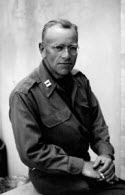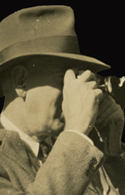Visual
Resources · Art
& Archaeology · Princeton
University · 205 McCormick Hall · Princeton, NJ 08544-1018
ONLINE EXHIBITIONS
 A. S. PENNOYER AND THE MONUMENTS MEN
A. S. PENNOYER AND THE MONUMENTS MEN
The Monuments, Fine Arts, and Archives program (MFAA) was established in 1943 to assist in the protection and restitution of cultural monuments in war areas during and following World War II. Dubbed the "Venus Fixers" or "Monuments Men," this group of art historians, curators, architects, and artists joined military forces to protect statues, paintings, historic buildings, and other important cultural landmarks. After the collapse of the third Reich, the MFA officers oversaw the hunt for the priceless art treasures that had been hidden in more than a thousand locations across Germany and Austria. By the time the Allied forces reached Germany, the mission had shifted from protection of monuments to restitution of stolen artworks.
Albert Sheldon Pennoyer, a California artist and captain in the U.S. Army, served with the MFAA in Italy from 1944 to 1945. Issued a Leica camera, and a car and driver, he traveled the front lines photographing fellow monuments officers assessing damage to landmarks and performing emergency restoration.
 EGYPTIAN ART AND ARCHITECTURE IN CONTEXT
EGYPTIAN ART AND ARCHITECTURE IN CONTEXT
This exhibition of late-nineteenth- and early-twentieth-century photographs of Egyptian art and architecture is mounted in conjunction with Deborah Vischak’s course, “The Ancient Egyptian Body,” and the upcoming conference, “The Egyptian Image in Context.” The central theme of both the course and the conference is context.
 AN ACCIDENTAL TOURIST IN POST WORLD WAR II JAPAN
AN ACCIDENTAL TOURIST IN POST WORLD WAR II JAPAN
The photographs in this exhibition are not the product of a photo journalist and are not official documents made for submission to SCAP or GHQ, but rather the work of an accidental tourist, Egbert Giles Leigh, during his time in Japan working as a US government agent during the US occupation.
 GLOBAL VIEWS: NINETEENTH CENTURY TRAVEL PHOTOGRAPHS
GLOBAL VIEWS: NINETEENTH CENTURY TRAVEL PHOTOGRAPHS
This exhibition of vintage photographs provides a glimpse of the golden age of travel photography in the second half of the nineteenth century, when the concurrent development of photography and tourism produced an impressive body of images produced by the some of the nineteenth century’s leading photographers.
 pasts presents futures: 125 years of art and archaeology at princeton university
pasts presents futures: 125 years of art and archaeology at princeton university
A glimpse of the past, a nod to the present, and a look to the future of the Department of Art and Archaeology as it celebrates 125 years as a pinnacle of culture at Princeton University. (1877-2007)
 POLIS CHRYSOCHOUS
POLIS CHRYSOCHOUS
The modern village of Polis Chrysochous lies at
the west end of the island of Cyprus at the mouth of an intermittent river
called the Chrysochou. Princeton University began a survey of the area
of in 1983; the excavation began in 1984 and continues today.
The photographs, with the exception of the two site pictures, were taken by Elisabeth Childs. All the objects depicted here are in the Archaeological Museum of Polis Chrysochous and while some are from the excavations of Princeton University, others come from rescue operations over many decades, primarily when ancient tombs were found, by chance, at modern construction sites. The objects were taken in natural daylight only, in the atrium of the newly built museum.
The photographs, with the exception of the two site pictures, were taken by Elisabeth Childs. All the objects depicted here are in the Archaeological Museum of Polis Chrysochous and while some are from the excavations of Princeton University, others come from rescue operations over many decades, primarily when ancient tombs were found, by chance, at modern construction sites. The objects were taken in natural daylight only, in the atrium of the newly built museum.
 THe HOUSE IN LATE ANTIQUE SYRIA
THe HOUSE IN LATE ANTIQUE SYRIA
Howard Crosby Butler, Princeton professor of Art
and Archaeology and the founder of the School of Architecture, led a series
of archaeological expeditions to Syria (1899-1900, 1904-5, and 1909).
The collective aim was to record the remains of ancient buildings and
settlements. The results of those expeditions were published in several
volumes that remain standard research tools for the study of late antique
architecture in Syria. Many of the photographs and drawings made by Butler
a century ago constitute unique documentation of the buildings, some of
which have long since disappeared. This exhibition, a selection of Butler's
original photographs and drawings from the Department of Art and Archaeology's
Research Photograph Collections, highlights Syrian residential architecture
between the fourth and sixth century.
 MORGANTINA
MORGANTINA
Excavations at Morgantina were carried out from 1955 to 1963 and 1966 to 1967 by the Princeton University Archaeological Expedition to Sicily under the joint directorship of Professors Erik Sjöqvist and Richard Stillwell. From 1968 to 1972, Hubert L. Allen *69, professor of classics, University of Illinois, continued the excavations under the auspices of the jointly sponsored Illinois-Princeton Morgantina Expedition. William A. P. Childs '64, 72*, professor of classical art and archaeology at Princeton University, served as a trench master in 1966 and as field director in 1978 and 1979. In 1989, Malcolm Bell III, '63, 72*, professor of art history at the University of Virginia, took over the supervision of the excavations. Today the excavations at Morgantina remain under the direction of Malcolm Bell and Carla Antonaccio *87, professor of classical studies at Duke University.
 THE MONASTERY OF ST. CATHERINE AT MOUNT SINAI
THE MONASTERY OF ST. CATHERINE AT MOUNT SINAI
The Monastery of St. Catherine at Mount Sinai is one of the best-known early monastic establishments.
Situated in the barren wilderness of the Sinai Peninsula, the monastery is dominated by the mighty massif
of Mt. Sinai (Jebel Musa) where, according to the Biblical tradition, Moses received the Tablets of the Law
from God.
The exhibition was organized to commemorate Kurt Weitzmann (1904-93) and the Princeton-Michigan expedition to Mt. Sinai. Weitzmann, professor of art and archaeology at Princeton (1945-72) and his colleague George Forsyth, then professor at the University of Michigan (Ann Arbor), organized a series of expeditions (1956-65) to Mount Sinai, with the aim of studying the Monastery of St. Catherine and its treasures. The results of these expeditions, published in several volumes on the architecture of the monastery and the church, the mosaics, icons, and manuscripts, have made a major impact on the course of study of Byzantine art.
The exhibition was organized to commemorate Kurt Weitzmann (1904-93) and the Princeton-Michigan expedition to Mt. Sinai. Weitzmann, professor of art and archaeology at Princeton (1945-72) and his colleague George Forsyth, then professor at the University of Michigan (Ann Arbor), organized a series of expeditions (1956-65) to Mount Sinai, with the aim of studying the Monastery of St. Catherine and its treasures. The results of these expeditions, published in several volumes on the architecture of the monastery and the church, the mosaics, icons, and manuscripts, have made a major impact on the course of study of Byzantine art.